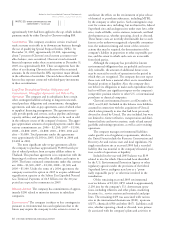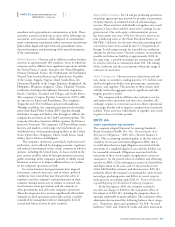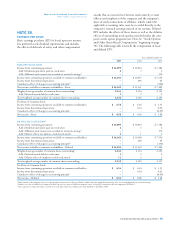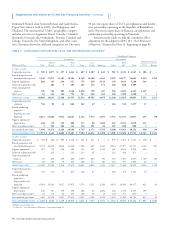Chevron 2005 Annual Report Download - page 85
Download and view the complete annual report
Please find page 85 of the 2005 Chevron annual report below. You can navigate through the pages in the report by either clicking on the pages listed below, or by using the keyword search tool below to find specific information within the annual report.
CHEVRON CORPORATION 2005 ANNUAL REPORT 83
NOTE 23. OTHER CONTINGENCIES AND
COMMITMENTS – Continued
remediate soil or groundwater contamination or both. These
and other activities include one or more of the following: site
assessment; soil excavation; offsite disposal of contaminants;
onsite containment, remediation and/or extraction of petroleum
hydrocarbon liquid and vapor from soil; groundwater extrac-
tion and treatment; and monitoring of the natural attenuation
of the contaminants.
Global Operations Chevron and its affi liates conduct business
activities in approximately 180 countries. Areas in which the
company and its affiliates have signifi cant operations include
the United States, Canada, Australia, the United Kingdom,
Norway, Denmark, France, the Netherlands, the Partitioned
Neutral Zone between Kuwait and Saudi Arabia, Republic
of the Congo, Angola, Nigeria, Chad, South Africa, the
Democratic Republic of the Congo, Indonesia, Bangladesh, the
Philippines, Myanmar, Singapore, China, Thailand, Vietnam,
Cambodia, Azerbaijan, Kazakhstan, Venezuela, Argentina,
Brazil, Colombia, Trinidad and Tobago, and South Korea.
The company’s Caspian Pipeline Consortium (CPC) affi li-
ate operates in Russia and Kazakhstan. The company’s
Tengizchevroil (TCO) affiliate operates in Kazakhstan.
Through an affi liate, the company participates in the develop-
ment of the Baku-Tbilisi-Ceyhan (BTC) pipeline through
Azerbaijan, Georgia and Turkey. Also through an affi liate, the
company has an interest in the Chad/Cameroon pipeline. The
company’s Petrolera Ameriven affi liate operates the Hamaca
project in Venezuela. The company’s CPChem affiliate manu-
factures and markets a wide range of petrochemicals on a
worldwide basis, with manufacturing facilities in the United
States, Puerto Rico, Singapore, China, South Korea, Saudi
Arabia, Qatar, Mexico and Belgium.
The company’s operations, particularly exploration and
production, can be affected by changing economic, regulatory
and political environments in the various countries in which it
operates, including the United States. As has occurred in the
past, actions could be taken by host governments to increase
public ownership of the company’s partially or wholly owned
businesses or assets or to impose additional taxes or royalties
on the company’s operations or both.
In certain locations, host governments have imposed
restrictions, controls and taxes, and in others, political
conditions have existed that may threaten the safety of
employees and the company’s continued presence in those
countries. Internal unrest, acts of violence or strained rela-
tions between a host government and the company or
other governments may affect the company’s operations.
Those developments have at times signifi cantly affected the
company’s related operations and results and are carefully
considered by management when evaluating the level of
current and future activity in such countries.
Equity Redetermination For oil and gas producing operations,
ownership agreements may provide for periodic reassessments
of equity interests in estimated crude oil and natural gas
reserves. These activities, individually or together, may result
in gains or losses that could be material to earnings in any
given period. One such equity redetermination process
has been under way since 1996 for Chevron’s interests in
four producing zones at the Naval Petroleum Reserve at
Elk Hills, California, for the time when the remaining inter-
ests in these zones were owned by the U.S. Department of
Energy. A wide range remains for a possible net settlement
amount for the four zones. Chevron estimates its maximum
possible net before-tax liability at approximately $200. At
the same time, a possible maximum net amount that could
be owed to Chevron is estimated at about $50. The timing
of the settlement and the exact amount within this range of
estimates are uncertain.
Other Contingencies Chevron receives claims from and sub-
mits claims to customers, trading partners, U.S. federal, state
and local regulatory bodies, host governments, contractors,
insurers, and suppliers. The amounts of these claims, indi-
vidually and in the aggregate, may be signifi cant and take
lengthy periods to resolve.
The company and its affi liates also continue to review
and analyze their operations and may close, abandon, sell,
exchange, acquire or restructure assets to achieve operational
or strategic benefi ts and to improve competitiveness and prof-
itability. These activities, individually or together, may result
in gains or losses in future periods.
NOTE 24.
ASSET RETIREMENT OBLIGATIONS
The company adopted Financial Accounting Standards
Board Statement (FASB) No. 143, “Accounting for Asset
Retirement Obligations,” (FAS 143), effective January 1,
2003. This accounting standard applies to the fair value of
a liability for an asset retirement obligation (ARO) that is
recorded when there is a legal obligation associated with the
retirement of a tangible long-lived asset and the liability can
be reasonably estimated. Obligations associated with the
retirement of these assets require recognition in certain cir-
cumstances: (1) the present value of a liability and offsetting
asset for an ARO, (2) the subsequent accretion of that liability
and depreciation of the asset, and (3) the periodic review
of the ARO liability estimates and discount rates. FAS 143
primarily affects the company’s accounting for crude oil and
natural gas producing assets and differs in several respects
from previous accounting under FAS 19, “Financial Account-
ing and Reporting by Oil and Gas Producing Companies.”
In the fi rst quarter 2003, the company recorded a
net after-tax charge of $200 for the cumulative effect of
the adoption of FAS 143, including the company’s share of
amounts attributable to equity affi liates. The cumulative-effect
adjustment also increased the following balance sheet catego-
ries: “Properties, plant and equipment,” $2,568; “Accrued
liabilities,” $115; and “Deferred credits and other noncurrent
























